I am pretty reluctant to get anywhere near the Cascadian Independence movement. I know they’re serious people, thinking hard about a really true independent country. I’m not one of them, but I appreciate Cascadia (obviously) and I appreciate they’re work, but only as a venue to sharpen our concept of Cascadia. Whatever political system we’re using, there is plenty of work in the near term to get done.
And, I think, in the jet wash of the recent Scottish Independence vote, there are some lessons for Cascadians (seeking independence or not).
1. Rural vs. Urban divide doesn’t need to divide us.
Whether you’re like me and drawn the line at the Cascades, or draw in a much larger swath of the interior west, there’s a sharp divide between rural and urban up here.
There was a similar urban/rural split in the Scottish vote. Essentially, poorer urban areas went for the breakup, while richer rural areas voted for union. This is ironic because the political party that sparked independence originally had support in rural areas.
In Cascadia the rural urban divide is based on a non-Cascadian Republican/Democratic political divide. But, as we’ve seen in some local election results, rural and urban voters can get together to elect particularly Cascadian politicians.
2. Changing politics will change politics.
In the short term, the people who want an independent Cascadia should focus on just making Cascadia better. More people voting, more people engaged, a better politics. If, once we get more people involved at all areas of politics and government, we still want out? Then cross that bridge them.
The Scots began to see themselves differently, as representing a different sort of politics:
In the meantime, pro-independence activists have managed to capture the
hearts and imaginations on many voters in Scotland in a way that the
unionist camp has not. Drawing inspiration from what are considered to
be the fairer and more prosperous Nordic countries with high levels of
democratic participation, many in Scotland became involved in the
campaign at the grassroots level.
Scotland Independence vote was built on the back of a new sort of politics:
The idea of the public as passive,
inert spectators and with it the notion of politics as a minority
report pastime, no longer holds. Instead, across the country a new
energetic, dynamic political culture emerged which reshaped public
debate and conversations.It could be seen in the massive
turnouts which saw poorer and disadvantaged communities turn out in
record numbers. What I called ‘the missing Scotland’ – the
voters who haven’t voted in a generation or more – re-emerged as
a potent political force which has the potential to reshape long term
politics. It was also seen in the re-imagination of public spaces,
the emergence of flash mobs and protest, and a culture of celebration
and carnival on the Yes side.
The other dimension found expression in
‘the third Scotland’ – the self-organised, independent minded
supporters of independence – who have had a very different and
distinct politics from the SNP. These groups: Radical Independence
Campaign, National Collective, Common Weal, Women for Independence
and several others, saw independence not as an end in itself, but as
a means to an end.They brought DIY culture, network
politics, flat organisations and part of a new generation of young
people into public life. They did things which were messy, fuzzy,
creative and fun. They staged happenings, art installations, and
national tours across Scotland, and in the case of Radical
Independence they door stepped and challenged Nigel Farage when he
came to Edinburgh last year. All of this contributed to a different
kind and feel of politics which circumvented the ‘official’
version which was a high bound to command and control as any part of
Westminster.



